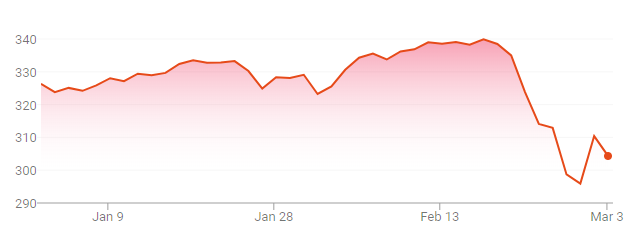
As I write this, the biggest story in the entire world is a virus that is making its way around the planet, leaving a trail of sickness and death in its wake, while sending a much bigger shockwave of fear and uncertainty out front. Last week, the US stock market dropped 15% in just a few days, the most shocking correction since the 2008-2009 financial crisis (and the most interesting drop since the founding of this blog in 2011).
I am sure you’ve been hearing, reading or watching plenty about it already, but the real question is, what should we do about it?
The Scary Side

The fear and doubt seems to be what the news stories have been emphasizing. The disease is highly contagious, and very sneaky. Each carrier seems to infect 2-3 additional people, which means exponential growth. And with an observed death rate of about 1% so far (on a limited data set of older people on a cruise ship) it may be several times times more deadly than the common flu.
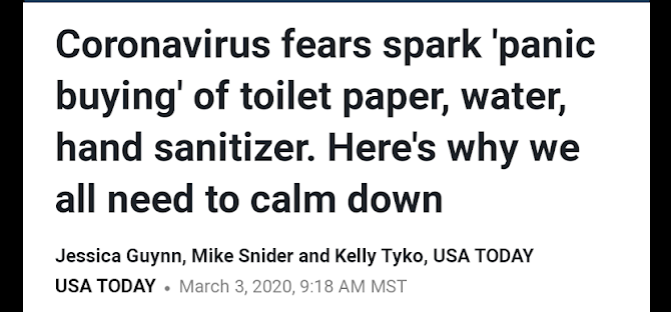
On the news, we see rows of hastily installed hospital beds, people wearing paper face masks even here in our own country, empty supermarket shelves and shuttered factories and public venues.
And we are reminded that we ain’t seen nothing yet, because with mild symptoms that can hide for days, most cases are going unreported and the disease is pumping its toxic tentacles through the arteries of our economy, plotting its attack while we are left POWERLESS UNTIL THE RIOTS IN THE STREET START AND PEOPLE ARE SMASHING THROUGH OUR WINDOWS TO TAKE OUR LAST FEW CANS OF BEANS AFTER WE RUN OUT OF AMMO IN OUR SHOTGUNS.
Some people are just prone to this type of thinking, and I even have a few in my own life. They have warned me to gather “at least a few months worth” of nonperishable food in my pantry and make sure I have a generator and plenty of fuel, at the very least. And to reconsider my stance of not keeping any guns in the house.
The Not-So-Scary Side

As I write this on March 2nd, there have been about 90,000 confirmed cases of COVID-19. And while the number is still growing rapidly, at the moment it is still a tiny number, about one thousandth of a percent of the world’s population. So even if it multiplies 100-fold, it would be a tenth of one percent. And out of these 90,000 people, about half are already recovered and have moved on with their lives. And the vast majority of the remaining ill, and all those who are so far undetected, and those who are yet to get infected, will also recover.
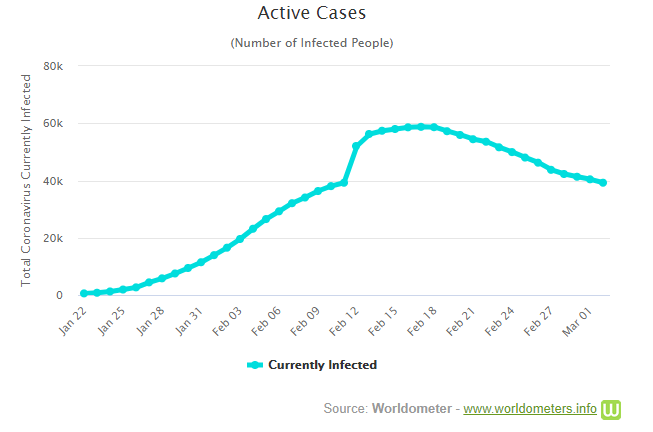
But do we have any idea how bad it will get, before it gets better? As it turns out, we do. But first, some perspective.
Here are this year’s numbers for the tried-and-true traditional flu for the 2019 flu season in the US alone (and remember the USA is only four percent of the world population):
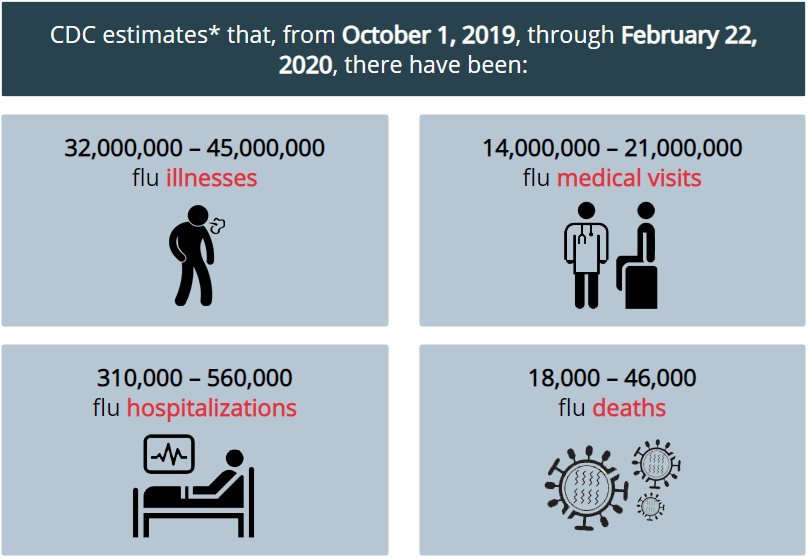
Wow, 32-45 million cases of the flu already, and tens of thousands of deaths. Even I had no idea it was that serious, and yet the flu is something I don’t even worry about – ever!
Even scarier: every year, about 2.8 million people die in the US alone, and a full 70% of these deaths (over two million people per year) are caused by “lifestyle factors”, which to put it plainly means ignoring Mr. Money Mustache’s advice about bikes, barbells and salads every day.
So if we start with the common flu, which is surprisingly scary, choosing car-based transportation and TV-based entertainment and consuming processed high-carbohydrate food and soft drinks should feel at least an additional hundred times scarier than that.
But do you feel the appropriate ratios of fear in these two situations? And a much smaller amount of fear about the Coronavirus? Probably not, because we humans generally suck at putting numbers, statistics and probabilities into perspective.
We Have Been Here Before
In my lifetime alone, we have seen the rise and decline of quite a list of worldwide health scares, each of which was covered in the news with similar intensity to what we see today. AIDS, Ebola, SARS, Bird Flu, and the 2009 Swine Flu pandemic, also known as H1N1. That one was particularly serious in retrospect, having infected between 11-21% of the world’s population and taking the lives of about 500,000.
Yet here we are, with that fearful event gone from the rearview mirror and a global economy that is far richer than it has ever been. Which is exactly what we will eventually be saying about the present moment in time, from our vantage point in the even more prosperous future.
And Math Can Help Create Perspective
Contagious diseases don’t just grow forever until everybody is dead. They follow an S-curve, like this recent prediction for Covid-19’s spread. It currently estimates that we may see things flatten out fairly soon, but more importantly it continually updates to new information and makes an educated guess – a great strategy for dealing with unknowns in life in general.
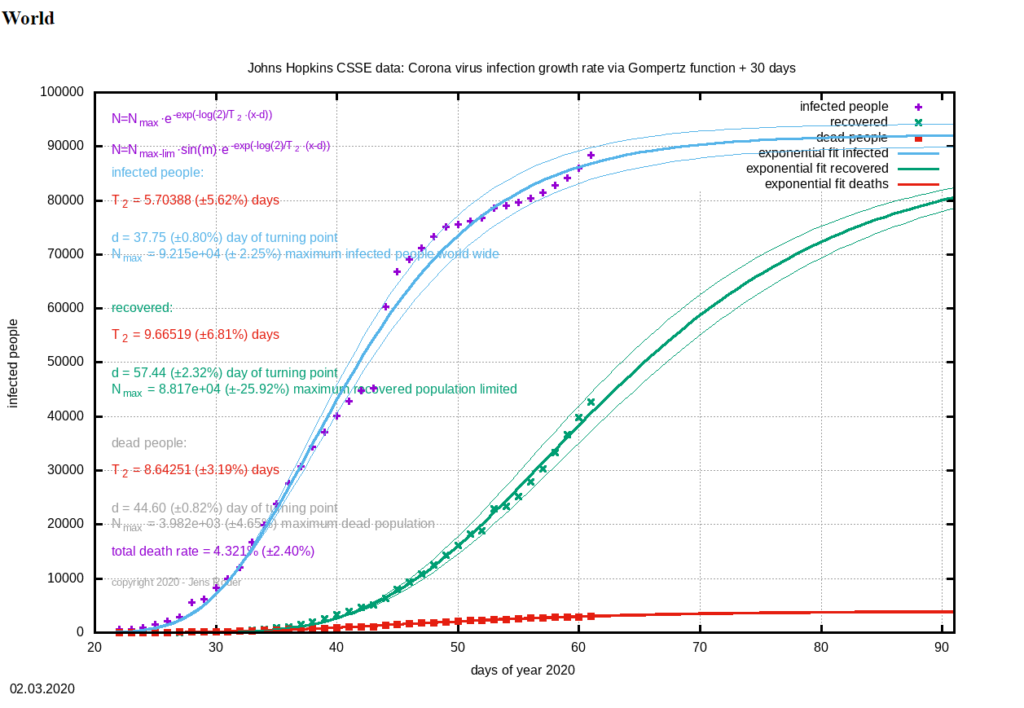
On the other hand, some estimates are more pessimistic. Disease modelers at Northeastern University used different assumptions in mid-February to predict between 550,000 and 4 million cases in China*, before we reach the flat top of our “S”. That because of extreme quarantines, that turned out to be pessimistic as well and China flattened out well below 100k.
So let’s imagine that a 4-million outbreak happened in the rest of the world. That’s still only a twentieth of one percent of the world’s population who would even get the disease, and then a further 99% of those would recover. Again, it’s too early to guess the world numbers, and I’m not qualified to do so. But it’s always important to put things into context of the almost eight billion people on Earth – that’s a deceptively large number.
As a final source of information, when it comes to world health issues I always like to see what Bill Gates has to say. And sure enough, he written this great opinion piece in a medical journal and an even better Ask Me Anything on Reddit. His main point? The damage done by a virus really depends on how well our governments respond to it. Lots of caution and a quick response leads to much better results.
So there’s still a lot of uncertainty. But when faced with a lack of information, we can choose one of two options on where to learn more:
- Good looking news anchors with fake tans and no scientific background, who make more money if they generate more viewership hours and advertising revenue, which is proven to multiply if they can cause their viewers to experience fear, or
- Scientists and mathematicians who study this stuff for a living, and use incoming data to make a series of continually refined predictions.
As Mustachians, we get our information from scientists rather than news anchors and politicians, and then we choose a course of action based on what is in our circle of control. In the case of the Coronavirus, I would say that means taking the following steps:
- Continue the usual program of living a healthy life. Just the incredibly simple steps of cutting cars, sugar and television out of your life as much as possible will virtually eliminate the 70% fatality risk factor of being inactive and unfit – and yet only a tiny percentage of people – even those lucky enough to still have fully able bodies – actually follow this advice. On top of that, this strategy will also greatly boost your immunity to Covid-19, and decrease your chance of serious illness or death if you do catch it.
- Don’t try to out-guess the stock market. Just celebrate the fact that we have a temporary sale on stocks. While the endless stream of meaningless market commentary every day means absolutely nothing, one fact remains indisputable: stocks you buy today at a 15% discount from their peak, will be 15% more profitable for you over your lifetime.
- And finally, still important but statistically less urgent is taking actual steps related to dodging this and other viral illnesses. Wash your hands a few times a day and avoid unnecessary large gatherings of people in close quarters, until the health organizations tell us we are in the clear.
Guns and ammo and a bunker full of canned beans not required.
* a really interesting quote from that same article about the size of the uncertainty around diseases:
” In the autumn of 2014, modelers at CDC projected that the Ebola outbreak in West Africa could reach 550,000 to 1.4 million cases in Liberia and Sierra Leone by late January if nothing changed. As it happened, heroic efforts to isolate patients, trace contacts, and stop unsafe burial practices kept the number of cases to 28,600 (and 11,325 deaths). “
Advertisement – An MMM-Recommended Bonus as of March 22, 2020:
The last couple of week’s unprecedented 1.5% drop in US interest rates is a once-in-a-lifetime opportunity to cut down interest costs on any remaining mortgages or student loans you still have. Check out Credible.com for a fast check on whether or not it is worthwhile in your own situation.
Student loans click here ($300 bonus for MMM readers!)
note – Credible has now joined the short list of approved MMM affiliates, see more info here if you are curious how I handle them.
[ad_2]
Source link

